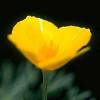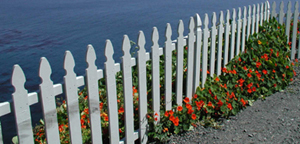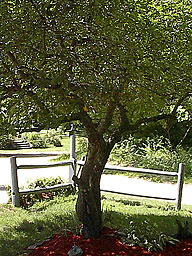Gardens of Middle-earth: Hobbiton
So you have a Hobbit bedroom, kitchen and bathroom. All you need to make your own home into Bag End is a Hobbit garden. Look no further! Whether you have the gardening expertise of the Gaffer or are a complete beginner, this is the place to get the ideas to turn your back yard into a garden fit for Bilbo!
Sam’s Hobbiton Garden
Vegetable Garden,Party Garden, and Other Features

Plant bright flowers in beds to bring colour into your garden. Simple blossoms with brightly coloured petals look most Hobbit-y. Nasturtiums, snapdragons and sunflowers all look good as well as sweetpeas, pansys, geraniums, cornflowers, poppies, petunias and crocuses.

California Poppies


Nasturtiums

Simbelmyne also suggests:
- Geranium Maverick White
- Rose Brandy
- Pink Marigold
- Geranium Champagner
- Daffodils
- Foxglove (Fairy Thimble)
- Iris
Fruit Trees and Vegetables

The best trees to have in a Hobbiton garden are fruit trees. Apples, plums and cherry trees all give lots of fruit which can be used in Hobbit recipes. (See Pippin’s Recipe Box for more ideas.)
Everyone knows that Hobbits love food and homegrown vegetables taste a lot better than shop bought ones. Grow your own vegetables in a vegetable patch. Carrots, peas, potatoes, cabbage and lettuce can all be grown and can later be turned into scrummy meals. Strawberries can also be grown along with other berries and later turned into delicious jams and filling for tarts and pies.
Of course you will need seasoning for all your Hobbit recipes. Why not grow your own herbs? They are much tastier than the dried variety. Below is a list of herbs that you might wish to use:
Common Name: Angelica

Scientific Name: Angelic Archangelica
Type: perennial herb
Size: 5″-8″ high
Exposure: sun to partial shade
Culinary Uses: no culinary value
Other Uses: Angelica is only an angel in the garden if you are going on looks. It adds substantial beauty to your herb garden, but not much else.
Cultivation: Angelica can be started from seeds or purchased as established plants. Not suitable for containers. Rich, moist, well drained soil recommended.
Description: Angelica is slightly aromatic, but can cause skin irritation of hands in some instances. It blooms a in late Spring and attracts birds and insects.
Common Name: Basil

Scientific Name: Ocimum basilicum
Type: annual culinary herb
Size: 1″-3″ high
Exposure: full sun
Culinary Uses: compatible with most vegetables, meats, cheese, rice and eggs
Other Uses: bouquets, potpourri, tonics, baths
Cultivation: Start from seeds or store bought plants when weather turns warm. Can also be grown in a medium pot on a sunny windowsill. May need to be staked when it reaches full height. It will need to be pinched back to prevent it from getting too unruly.
Description: In late summer Basil will have white blooms. At this time it loses its taste, so it is recommended to pinch these off as they form. Basil attracts bees and other insects to its aromatic scent. There are many types of this plant to choose from.
Common Name: Dill

Scientific Name: Anethum graveolens
Type: perennial herb
Size: 24″-36″ high
Exposure: full sun
Culinary Uses: Enhances flavors of meat and pickles, best used fresh.
Other Uses: Strengthens fingernails when used in a bath.
Cultivation: Start from seeds in permanent location. Needs rich soil.
Description: Both leaves and seeds used in cooking. Leaves are aromatic. Do not plant near fennel, or the plants will cross-pollinate.
Common Name: Sweet/English Lavender

Scientific Name: Lavandula angustifolia
Type: perrinial herb
Size: 1″-18″ high
Exposure: sun to partial shade
Culinary Uses: Adds delicate flavor to beverages and desserts.
Other Uses: Potpourri, sachets, flower arrangements, lotion.
Cultivation: Best started from cuttings. Will need to be clipped back the first year to prevent flowering; which is harmful until well established.
Description: Attracts insects to its fragrant leaves and purple flowers.
Common Name: Lemon Balm

Scientific Name: Melissa officinalis
Type: perrinial herb
Size: 12″-18″ high
Exposure: full sun
Culinary Uses: Can be added to any recipe with lemon juice, good in some drinks.
Other Uses: Add juice to furniture polish; use to attract bees to hives.
Cultivation: Easily started from seed; self sows; may become invasive.
Description: Attracts bees, has tan flowers in late summer.
Common Name: Sweet Marjoram

Scientific Name: Origanum majorana
Type: annual herb
Size: 2″-36″ high
Exposure: full sun
Culinary Uses: Used fresh or dried in many recipes.
Other Uses: ~no other uses~
Cultivation: Start from seed inside. Prefers rich soil.
Description: Has a pink or white blossom. Can be a perrinial, but for culinary use it is only good one season.
Common Name: Mint

Scientific Name: mentha
Type: groundcover herb
Size: 4″-1′ high
Exposure: full sun
Culinary Uses: Can be used in most recipes, and also in breath mints.
Other Uses: Various other uses.
Cultivation: Can only be grown from cuttings. Will take over most of the bed, so recommended in large pots/tubs or solitary beds only.
Description: Mint comes in thousands of varieties; all having different scents and tastes.
Common Name: Parsley

Scientific Name: Petroselinum crispum
Type: annual herb
Size: 1″ high
Exposure: sun to partial shade
Culinary Uses: Garnish, soup, potatoes, salad, egg dishes, sandwiches.
Other Uses: Various other uses
Cultivation: Start from seeds indoors. Does well in a pot.
Description: Attracts caterpillars and butterflies. Very pretty green foliage. The most common herb used. Comes in flat leaf or curly variety.

Vegetable Garden
Plants
- Cabbage Hispi
- Cauliflower Dok Elgon
- Celery
- Garlic
- Most herbs (Rosemary, Dill, Parsley etc.)
- Sweetcorn
- Tarragon (Herb)
- Tomatoes
- Tree Onion
- Turnip Snowball
Be aware that many of these plants also have poisonous parts, as well as those which are edible. Be sure you know what you’re planting and how to prepare for use in food.
Furniture and Garden Necessities
Paths not necessary
Square formation: my garden formation was in a square spiral from bottom right as you would see your garden: Turnip Snowball, Tree Onion, Tomatoes, Tarragon, Sweetcorn, Cabbage Hispi, Cauliflower Dok Elgon, Celery, a free space and Garlic in the centre.
Grass: Well-cut
Shed
Brown/reddish wood
Rectangular
Climbing Plants: Dutchman’s Pipe, English Ivy/English Ivy “Deltoidea”, Honeysuckle and Honeysuckle Woodbine.
One window, round if possible.
Party Garden
Plants
White Oak with chair placed beneath. Obviously a twenty-foot White Oak is beyond some gardens, so any large tree will probably do.
Also, climbing plants referred to for the shed could also be used on the fences.
Furniture and Garden Necessities
No paths
Either several little tables or a long table, preferably wooden.
Grass: Well-cut

Other Garden Features
Whether you are holding a small dinner party for four or have plans to seat one gross, outside is the best place to host it and show off your new Hobbiton garden at the same time. Buy rustic looking wooden seats from your local garden centre and wooden tables. When you have your party, cover the tables with a white linen table cloth before laying out your feast. Don’t forget that you need to weigh down the tablecloth to stop it blowing away!
Why not build a log pile as a feature? Not only is it great for those roaring Hobbit fires but it will encourage wildlife into your garden. The logs make an ideal hiding place for frogs and insects. Of course, if you are lucky then you might get mushrooms growing on your logs! (Unless you are an expert do not eat these as they may be poisonous.)
If you are looking for a water feature to complete your garden then why not have a stream? Dig out a channel which slopes downwards on your chosen spot with a reservoir at the bottom. Then cover the channel with sand to stop sharp stones ripping the liner. Once this is done put hardwaring pondliner down on top of the sand, remembering to leave an overlap. After that fit a pump to transfer the water from the reservoir to the top of your stream. (Safety warning- always be careful with electrics around water!) Fill your stream with water then switch on the pump and watch the stream flow!
You could have a cobblestone path, which is in keeping with the country atmosphere of the Shire, and Simbelmyne suggests that you keep your garden symmetrical in design, with the plants placed mainly alongside the path. Tanlaithwen’s Note: Plant the herbs in an organised fashion, but to get the real English Country Garden look, don’t plan your flowers too much. Scatter your seeds where you want them, take care of them, but make sure it looks natural.
Have fun making your own Hobbiton garden!

Thanks to Eloise, Simbelmyne, NenyaGold and Eowyn_Touched-By-Frost for researching and writing these pieces.










2 Comments
Sounds very good, I think I´ll plant most of it in my garden, this would be a better idea than letting grass and nessels grow… Love it!
Thanks!! Gives me some ideas of what include in my garden for this year!! Blessed be- Novaer